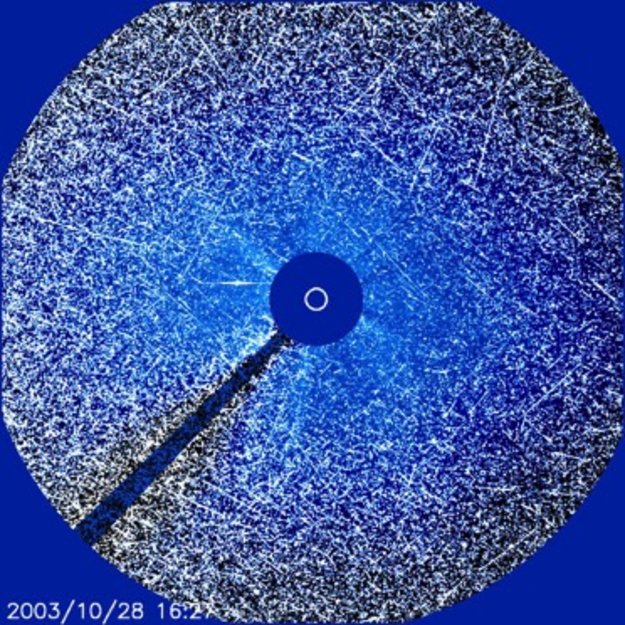http://www.esa.int/spaceinimages/Images/2016/12/Impact_of_a_solar_storm_28_October_2003
Impacto de una tormenta solar
12 diciembre 2016
Aunque esta escena parece el hipnótico resultado de agitar un domo de nieve, en realidad se trata del inquietante efecto de una de las tormentas solares más potentes jamás registradas.
Durante dos semanas en octubre y noviembre de 2003, el Sol permaneció inusitadamente activo, mientras unas enormes manchas solares, con un diámetro más de 10 veces superior al de la Tierra, generaban erupciones casi a diario.
Las erupciones solares se dividen según la energía que liberan a longitudes de onda de rayos X. Hay cinco categorías principales: A, B, C, M y X, que a su vez se dividen en otras 10 subclases. Las erupciones de tipo M1 son 10 veces más potentes que las de tipo C1, y las X1 son 10 veces más potentes que las M1; es decir, 100 veces más potentes que las C1.
Algunas de las erupciones observadas durante aquellas dos semanas fueron tan potentes que rebasaron el máximo de la categoría X, que suele denominarse X10. El 4 de noviembre se produjo una fulguración que, según los cálculos, habría alcanzado como mínimo el rango de X28.
El Observatorio Heliosférico y Solar (SOHO) de la ESA/NASA, lanzado en 1995 y que aún sigue en funcionamiento, vigilaba el comportamiento de la tormenta solar en aquellos momentos. Esta imagen muestra cómo sus detectores se vieron totalmente inundados por los protones de alta energía acelerados hasta casi la velocidad de la luz (300.000 km/s) durante una erupción de tipo X17 que se produjo el 28 de octubre de 2003.
Cuando la Tierra se encuentra en el punto de mira de las eyecciones de masa coronal asociadas, pueden producirse unas bellísimas y brillantes auroras en la atmósfera, que además nos ofrecen información muy valiosa sobre la interacción del Sol y la Tierra.
Estas eyecciones también pueden provocar graves perturbaciones en las comunicaciones por radio, el control del tráfico aéreo y las redes eléctricas.
Aunque estas potentes tormentas muestran el poder de la actividad solar, afortunadamente para nosotros, no se producen a menudo fulguraciones como las de 2003.
Esta imagen fue capturada por el instrumento LASCO C3 de SOHO. Un disco especial (indicado por el gran círculo azul) situado dentro del instrumento bloquea el Sol (indicado por el círculo blanco central), por lo que se pueden observar los detalles de la parte exterior de la atmósfera solar.
Aquí se puede ver un vídeo del fenómeno mostrado en esta escena.
Impact of a solar storm, 28 October 2003

- Title Impact of a solar storm, 28 October 2003
- Released 12/12/2016 11:48 am
- Copyright SOHO (ESA & NASA)
- DescriptionWhile this scene looks like the mesmerising result of shaking up a festive snow globe, it is in fact the disturbing effect of one of the most powerful solar storms ever recorded.Over two weeks in October and November 2003 the Sun was unprecedentedly active, with giant sunspots – over 10 times the diameter of Earth – generating flares on an almost daily basis.Solar flares are classed according to the energy they release at X-ray wavelengths. There are five major categories: A, B, C, M and X, further divided into 10 subclasses. M1 flares are 10 times more powerful than C1, and X1 flares are 10 times more powerful than M1 flares, or 100 times more powerful than C1.Some of the flares witnessed in this two-week period were so powerful they broke right through the top of the X-class range, which is usually given as X10. A flare erupting on 4 November was estimated to have reached at least X28.The ESA/NASA Solar and Heliospheric Observatory (SOHO), launched in 1995 and still operating today, was monitoring the Sun’s stormy behaviour during this time. This image shows its detectors being completely swamped by high-energy protons that were accelerated to nearly the speed of light (300 000 km/s) in the X17 flare of 28 October 2003.When Earth is in the firing line of associated coronal mass ejections (CMEs), it can lead to beautiful and bright auroras in the atmosphere, giving unparalleled insight into the interaction of the Sun and Earth.CMEs can also cause serious disruption to radio communications, air traffic control and power grids.Although these powerful storms reveal the extremes of the Sun’s activity, fortunately for Earth, those on the scale of the 2003 events do not occur very often.The image was taken by SOHO’s LASCO C3 instrument. A special disc (indicated by the large blue circle) inside the instrument blocks the Sun (indicated by the inner white circle), so that details of the extended outer solar atmosphere can be observed. Watch a movie of the event depicted in this scene, here.Credits: SOHO (ESA & NASA)
- Id 370785
Guillermo Gonzalo Sánchez Achutegui
ayabaca@gmail.com
ayabaca@hotmail.com
ayabaca@yahoo.com
Inscríbete en el Foro del blog y participa : A Vuelo De Un Quinde - El Foro!


No hay comentarios:
Publicar un comentario